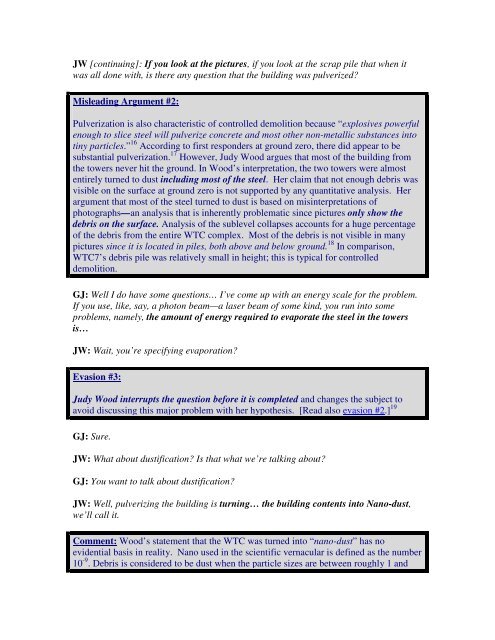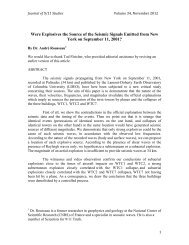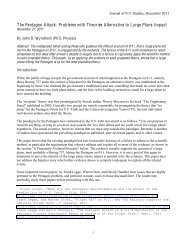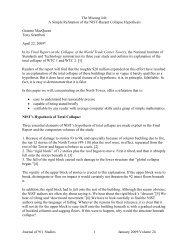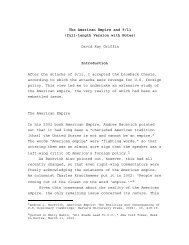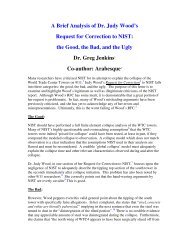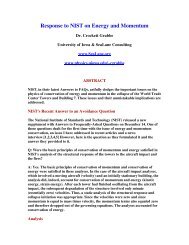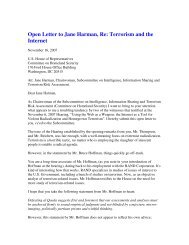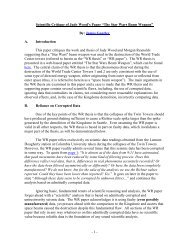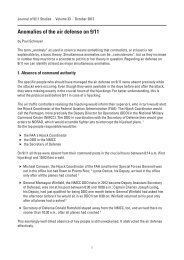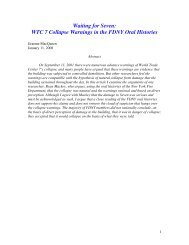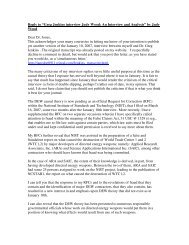interview with dr. judy wood and dr. greg jenkins - Journal of 9/11 ...
interview with dr. judy wood and dr. greg jenkins - Journal of 9/11 ...
interview with dr. judy wood and dr. greg jenkins - Journal of 9/11 ...
You also want an ePaper? Increase the reach of your titles
YUMPU automatically turns print PDFs into web optimized ePapers that Google loves.
JW [continuing]: If you look at the pictures, if you look at the scrap pile that when it<br />
was all done <strong>with</strong>, is there any question that the building was pulverized?<br />
Misleading Argument #2:<br />
Pulverization is also characteristic <strong>of</strong> controlled demolition because “explosives powerful<br />
enough to slice steel will pulverize concrete <strong>and</strong> most other non-metallic substances into<br />
tiny particles.” 16 According to first responders at ground zero, there did appear to be<br />
substantial pulverization. 17 However, Judy Wood argues that most <strong>of</strong> the building from<br />
the towers never hit the ground. In Wood’s interpretation, the two towers were almost<br />
entirely turned to dust including most <strong>of</strong> the steel. Her claim that not enough debris was<br />
visible on the surface at ground zero is not supported by any quantitative analysis. Her<br />
argument that most <strong>of</strong> the steel turned to dust is based on misinterpretations <strong>of</strong><br />
photographs—an analysis that is inherently problematic since pictures only show the<br />
debris on the surface. Analysis <strong>of</strong> the sublevel collapses accounts for a huge percentage<br />
<strong>of</strong> the debris from the entire WTC complex. Most <strong>of</strong> the debris is not visible in many<br />
pictures since it is located in piles, both above <strong>and</strong> below ground. 18 In comparison,<br />
WTC7’s debris pile was relatively small in height; this is typical for controlled<br />
demolition.<br />
GJ: Well I do have some questions… I’ve come up <strong>with</strong> an energy scale for the problem.<br />
If you use, like, say, a photon beam—a laser beam <strong>of</strong> some kind, you run into some<br />
problems, namely, the amount <strong>of</strong> energy required to evaporate the steel in the towers<br />
is…<br />
JW: Wait, you’re specifying evaporation?<br />
Evasion #3:<br />
Judy Wood interrupts the question before it is completed <strong>and</strong> changes the subject to<br />
avoid discussing this major problem <strong>with</strong> her hypothesis. [Read also evasion #2.] 19<br />
GJ: Sure.<br />
JW: What about dustification? Is that what we’re talking about?<br />
GJ: You want to talk about dustification?<br />
JW: Well, pulverizing the building is turning… the building contents into Nano-dust,<br />
we’ll call it.<br />
Comment: Wood’s statement that the WTC was turned into “nano-dust” has no<br />
evidential basis in reality. Nano used in the scientific vernacular is defined as the number<br />
10 -9 . Debris is considered to be dust when the particle sizes are between roughly 1 <strong>and</strong>


